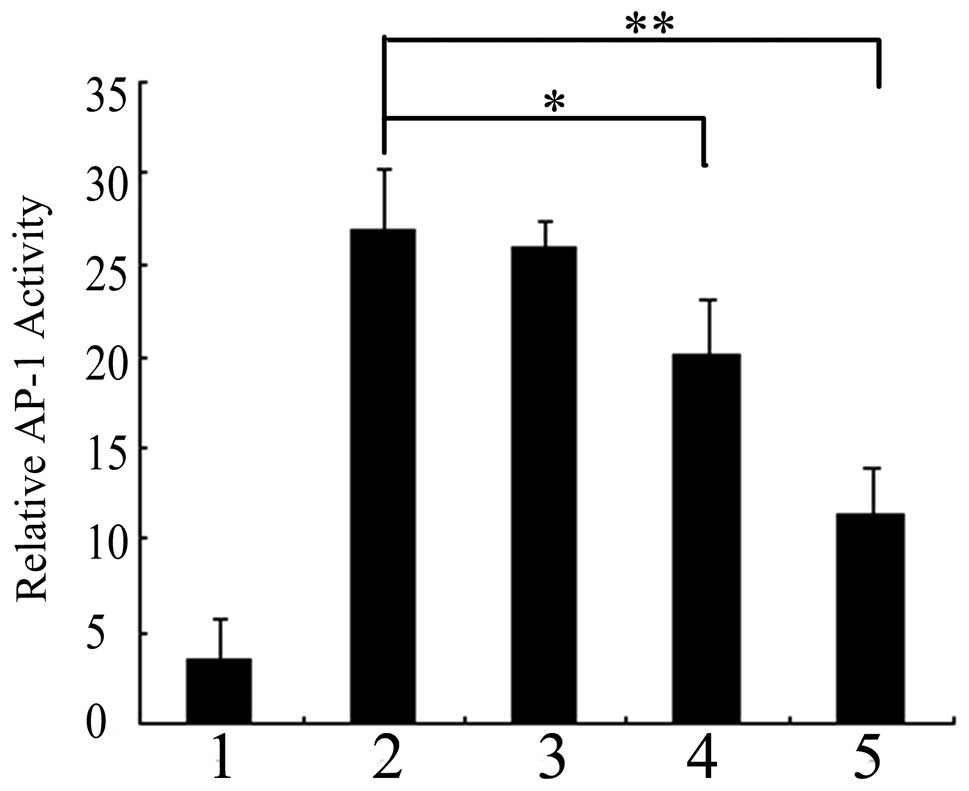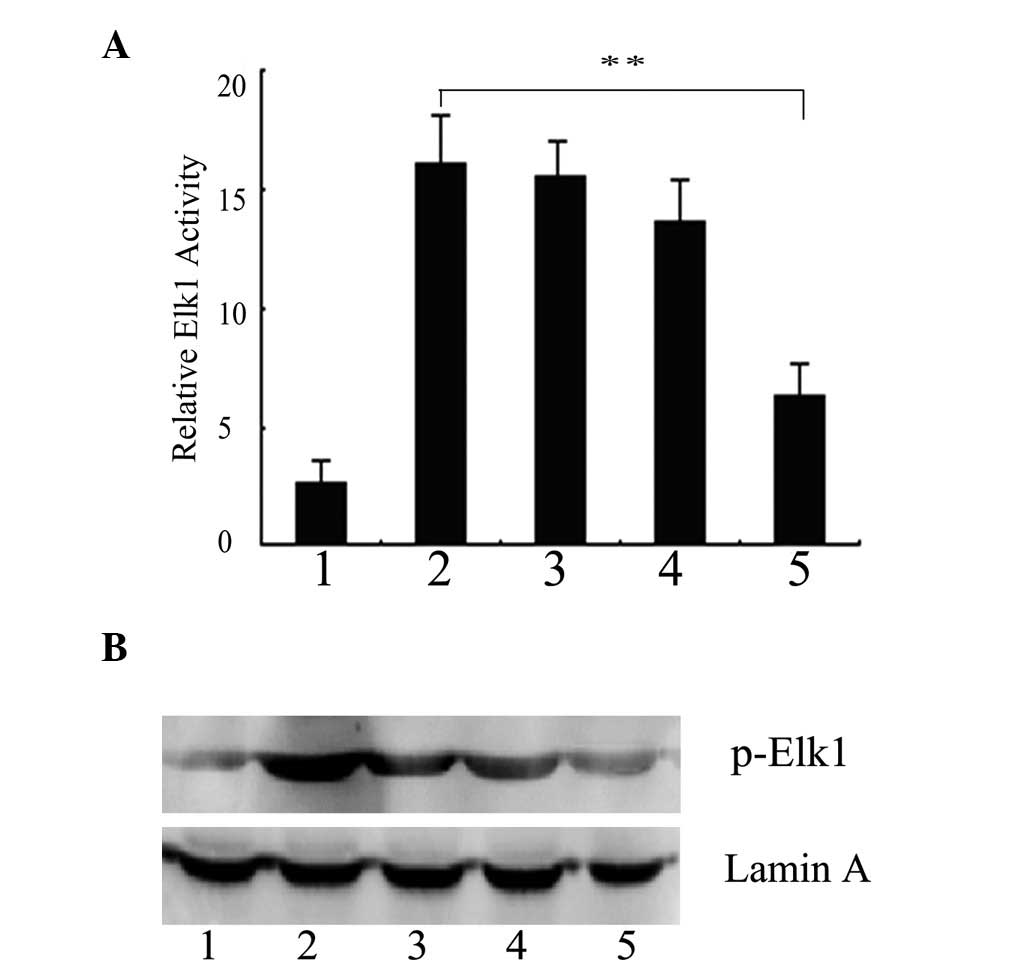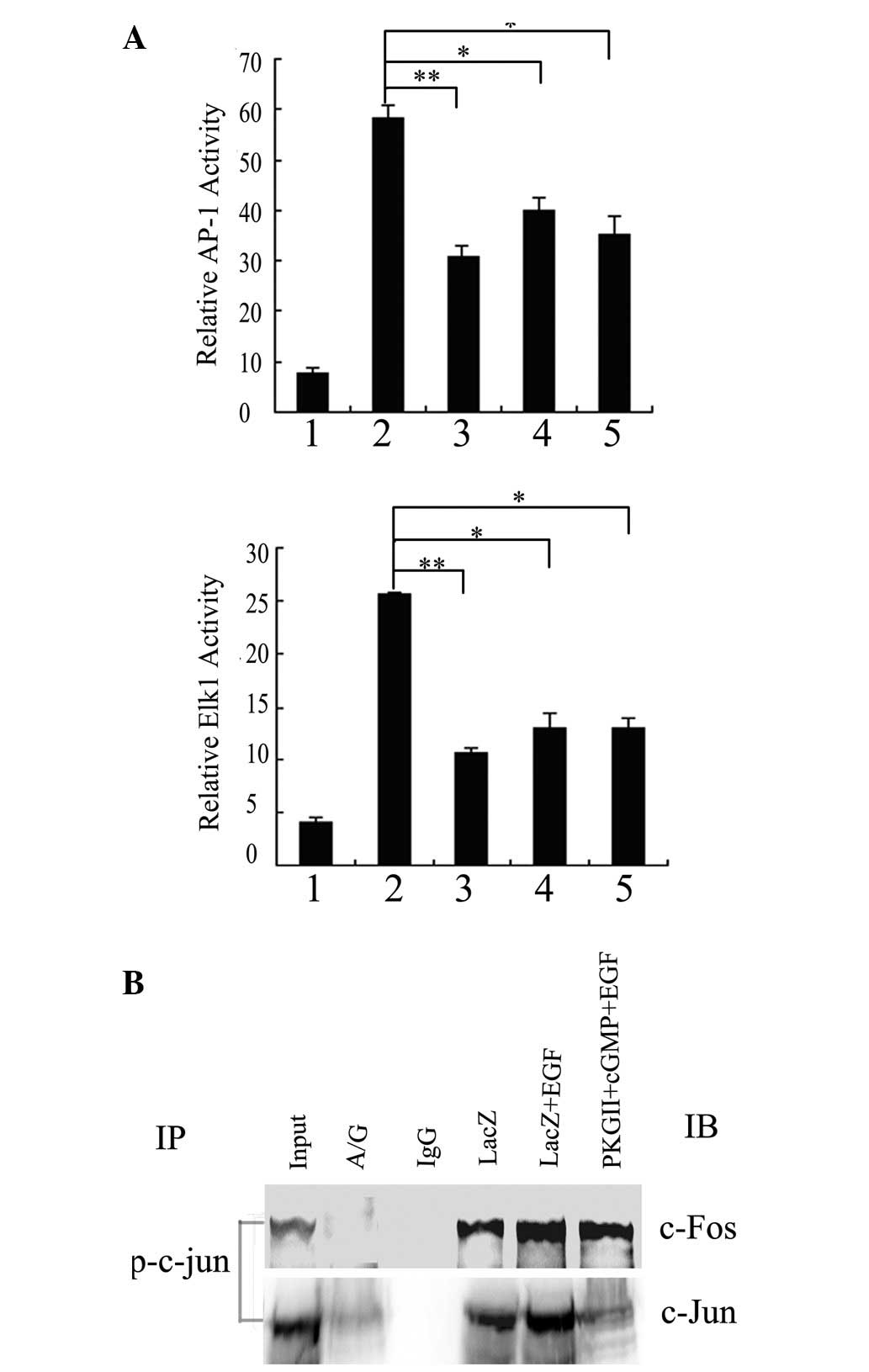|
1
|
Orstavik S, Natarajan V, Taskén K, Jahnsen
T and Sandberg M: Characterization of the human gene encoding the
type I alpha and type I beta cGMP-dependent protein kinase (PRKG1).
Genomics. 42:311–318. 1997. View Article : Google Scholar : PubMed/NCBI
|
|
2
|
Orstavik S, Solberg R, Taskén K, Nordahl
M, Altherr MR, Hansson V, Jahnsen T and Sandberg M: Molecular
cloning, cDNA structure and chromosomal localization of the human
type II cGMP-dependent protein kinase. Biochem Biophys Res Commun.
220:759–765. 1996. View Article : Google Scholar : PubMed/NCBI
|
|
3
|
Feil R, Hofmann F and Kleppisch T:
Function of cGMP-dependent protein kinases in the nervous system.
Rev Neurosci. 16:23–41. 2005.PubMed/NCBI
|
|
4
|
Pilz RB and Broderick KE: Role of cyclic
GMP in gene regulation. Front Biosci. 10:1239–1268. 2005.
View Article : Google Scholar : PubMed/NCBI
|
|
5
|
Hou Y, Gupta N, Schoenlein P, Wong E,
Martindale R, Ganapathy V and Browning D: An anti-tumor role for
cGMP-dependent protein kinase. Cancer Lett. 240:60–68. 2006.
View Article : Google Scholar : PubMed/NCBI
|
|
6
|
Cook AL and Haynes JM: Protein kinase G
II-mediated proliferative effects in human cultured prostatic
stromal cells. Cell Signal. 16:253–261. 2004. View Article : Google Scholar : PubMed/NCBI
|
|
7
|
Cook AL and Haynes JM: Phosphorylation of
the PKG substrate, vasodilator-stimulated phosphoprotein (VASP), in
human cultured prostatic stromal cells. Nitric Oxide. 16:10–17.
2007. View Article : Google Scholar : PubMed/NCBI
|
|
8
|
Wu Y, Chen YC, Qu R, Lan T and Sang JR:
Type II cGMP-dependent protein kinase inhibits EGF-triggered signal
transduction of the MAPK/ERK-mediated pathway in gastric cancer
cells. Oncol Rep. 27:553–558. 2012.PubMed/NCBI
|
|
9
|
Chen YC, Ren F, Sang JR, Tao Y and Xu WR:
Type II cGMP-dependent protein kinase inhibits proliferation of the
gastric cancer cell line BGC-823. Mol Med Rep. 3:361–366.
2010.PubMed/NCBI
|
|
10
|
Angel P and Karin M: The role of Jun, Fos
and the AP-1 complex in cell-proliferation and transformation.
Biochim Biophys Acta. 1072:129–157. 1991.PubMed/NCBI
|
|
11
|
Chiariello M, Marinissen MJ and Gutkind
JS: Multiple mitogen-activated protein kinase signaling pathways
connect the cot oncoprotein to the c-jun promoter and to cellular
transformation. Mol Cell Biol. 20:1747–1758. 2000. View Article : Google Scholar
|
|
12
|
Shaulian E and Karin M: AP-1 in cell
proliferation and survival. Oncogene. 20:2390–2400. 2001.
View Article : Google Scholar : PubMed/NCBI
|
|
13
|
Shaulian E and Karin M: AP-1 as a
regulator of cell life and death. Nat Cell Biol. 4:E131–E136. 2002.
View Article : Google Scholar : PubMed/NCBI
|
|
14
|
Eferl R and Wagner EF: AP-1: a
double-edged sword in tumorigenesis. Nat Rev Cancer. 3:859–868.
2003. View
Article : Google Scholar : PubMed/NCBI
|
|
15
|
Whitmarsh AJ, Shore P, Sharrocks AD and
Davis RJ: Integration of MAP kinase signal transduction pathways at
the serum response element. Science. 269:403–407. 1995. View Article : Google Scholar : PubMed/NCBI
|
|
16
|
Buchwalter G, Gross C and Wasylyk B: Ets
ternary complex transcription factors. Gene. 324:1–14. 2004.
View Article : Google Scholar
|
|
17
|
Hao D, Gao P, Liu P, Zhao J, Wang Y, Yang
W, Lu Y, Shi T and Zhang X: AC3–33, a novel secretory protein,
inhibits Elk1 transcriptional activity via ERK pathway. Mol Biol
Rep. 38:1375–1382. 2011.
|
|
18
|
Ely HA, Mellon PL and Coss D: GnRH induces
the c-Fos gene via phosphorylation of SRF by the calcium/calmodulin
kinase II pathway. Mol Endocrinol. 25:669–680. 2011. View Article : Google Scholar : PubMed/NCBI
|
|
19
|
Chen JC, Zhuang S, Nguyen TH, Boss GR and
Pilz RB: Oncogenic Ras leads to Rho activation by activating the
mitogen-activated protein kinase pathway and decreasing
Rho-GTPase-activating protein activity. J Biol Chem. 278:2807–2818.
2003. View Article : Google Scholar : PubMed/NCBI
|
|
20
|
Ono K and Han J: The p38 signal
transduction pathway: activation and function. Cell Signal.
12:1–13. 2000. View Article : Google Scholar
|
|
21
|
Milde-Langosch K: The Fos family of
transcription factors and their role in tumourigenesis. Eur J
Cancer. 41:2449–2461. 2005. View Article : Google Scholar : PubMed/NCBI
|
|
22
|
Brown JR, Nigh E, Lee RJ, Ye H, Thompson
MA, Saudou F, Pestell RG and Greenberg ME: Fos family members
induce cell cycle entry by activating cyclin D1. Mol Cell Biol.
18:5609–5619. 1998.PubMed/NCBI
|
|
23
|
Szabowski A, Maas-Szabowski N, Andrecht S,
Kolbus A, Schorpp-Kistner M, Fusenig NE and Angel P: c-Jun and JunB
antagonistically control cytokine-regulated mesenchymal-epidermal
interaction in skin. Cell. 103:745–755. 2000. View Article : Google Scholar : PubMed/NCBI
|
|
24
|
Karin M: The regulation of AP-1 activity
by mitogen-activated protein kinases. J Biol Chem. 270:16483–16486.
1995. View Article : Google Scholar : PubMed/NCBI
|
|
25
|
Gille H, Kortenjann M, Thomae O, Moomaw C,
Slaughter C, Cobb MH and Shaw PE: ERK phosphorylation potentiates
Elk-1-mediated ternary complex formation and transactivation. EMBO
J. 14:951–962. 1995.PubMed/NCBI
|
|
26
|
Ricote M, García-Tuñón I, Fraile B,
Fernández C, Aller P, Paniagua R and Royuela M: p38 MAPK protects
against TNF-alpha-provoked apoptosis in LNCaP prostatic cancer
cells. Apoptosis. 11:1969–1975. 2006. View Article : Google Scholar : PubMed/NCBI
|
|
27
|
Vikman P, Ansar S and Edvinsson L:
Transcriptional regulation of inflammatory and extracellular
matrix-regulating genes in cerebral arteries following experimental
subarachnoid hemorrhage in rats. Laboratory investigation. J
Neurosurg. 107:1015–1022. 2007. View Article : Google Scholar
|













